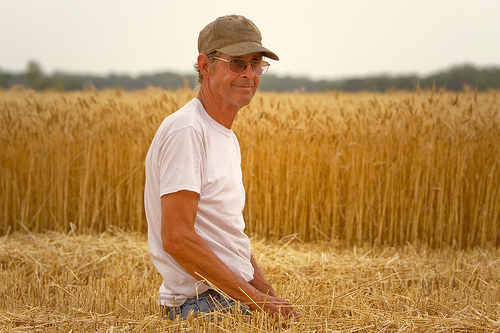Farmers Back Study

This study addresses low back disorders in Saskatchewan farmers, and will provide information on exposure to risk factors, extent of low back pain and disability, and self-initiated preventative measures. Studies in other jurisdictions and farm products show farmers have higher prevalence of low back disorders than non-farmers, resulting in disability, healthcare costs, and loss of farm income. Although this is anticipated to be true in Saskatchewan, the extent, impact, and causes of low back disorders have not been investigated in Saskatchewan farmers. Epidemiological studies have identified awkward postures, heavy loading, and vibration as broad categories of occupational exposures that are probable risk factors for back disorders. However, low-quality risk factors measurement have limited research of injury mechanisms and prevention efforts.
This foundational work will provide rich insight into an understudied issue in an understudied population, and allow for development of sampling strategies and exposure-prediction models for future epidemiological studies. The proposed study will answer the following research questions:
- What nature and extent of whole body (vehicle) vibration, awkward posture, and psychosocial risk factors encountered by Saskatchewan farmers in their work?
- What is the extent of low back disorder-related pain and disability experienced by Saskatchewan farmers?
- Are there trends indicating a cross-sectional relationship between working exposure and back pain or disability?
- Can physical exposures such as whole body vibration and posture be predicted using observed and self-reported farm and work task characteristics in a cost-effective model?
- What types of farmer-initiated preventative measures are currently used in farming, and what opportunities for prevention are identified by farmers?
To answer these questions, researchers will travel to 30 Saskatchewan farms to measure equipment vibration, lifting, and posture during the farmers’ regular work tasks. Farmers will be interviewed about any pain and/or disability using standardized interview questions. Farmers will also be asked about safety measures they have implemented at their farm, such as modified tools or equipment.
Low back disorders are an important public health issue among farmers in many regions and types of farming. We expect low back disorders to increasingly become a public health issue in Saskatchewan as well; however, these issues have not yet been investigated in Saskatchewan farmers. Considering the critical role that rural farmers play in Saskatchewan’s economy, further research to maintain farmer health is required. Occupational determinants of health such as vibration, heavy lifting, and awkward postures are important in the development and progression of low-back disorders. The results of this study will allow for cost-effective studies of these determinants in the future. By identifying safety measures, this study will also allow future research evaluating the effectiveness of prevention.
Publications and Resources
Study Report for Saskatchewan Farmers
Journal Articles
Bath, B., Jaindl, B., Dykes, L., Coulthard, J., Naylen, J., Rochelau, N., Clay, L., Khan, M.I., Trask, C. (2018). Get ‘Er Done: Experiences of Canadian Farmers Living with Chronic Low Back Disorders. Physiotherapy Canada. Dec 21(aop):1-10 https://utpjournals.press/doi/
Trask, C., Bath, B., Johnson, P. W., & Teschke, K. (2016). Risk factors for low back disorders in Saskatchewan farmers: Field-based exposure assessment to build a foundation for epidemiological studies. JMIR research protocols, 5(2).
Zeng, X., Kociolek, A. M., Khan, M. I., Milosavljevic, S., Bath, B., & Trask, C. (2016). Whole body vibration exposure patterns in Canadian prairie farmers. Ergonomics, 1-10.
Zeng, X., Trask, C. and Kociolek, A. M. (2017), Whole-body vibration exposure of occupational horseback riding in agriculture: A ranching example. Am. J. Ind. Med., 60: 215–220. doi:10.1002/ajim.22683
Zeng, X., Kociolek, A. M., Khan, M. I., Milosavljevic, S., Bath, B., & Trask, C. M. (2017). Predicting Whole-Body Vibration Exposure in Canadian Prairie Farmers. Annals of work exposures and health. doi: 10.1093/annweh/wxx025
Media Reports
Barb Glen, Sitting your way toward a bad back. March 7, 2019. Interviewed for an article in the Western Producer https://www.producer.com/2019/
Josh Martin, Oh, my aching back! Practical tips for preventing farm-related pain. Interviewed for an article in the print magazine Small Farm Canada. March/April 2019 http://smallfarmcanada.ca/
Brenna Bath and CatherineTrask, Back pain? A physiotherapist may offer the most effective treatment, if you can afford it. Lay report on The Conversation Canada, a web-based research repository. https://theconversation.com/
- Ottawa Citizen, February 14, 2019 https://ottawacitizen.com/pmn/
news-pmn/back-pain-a- physiotherapist-may-offer-the- most-effective-treatment-if- you-can-afford-it/wcm/ 5042dabd-feb0-4460-b42f- afd16ba4ca4d - The article was also translated into French and published on the Conversation Canada. «Mal de dos? Il vous faut moins de pilules, et plus de physiothérapie... si vous en avez les moyens»https://theconversation.com/mal-de-dos-il-vous-faut-moins-de-pilules-et-plus-de-physiotherapie-si-vous-en-avez-les-moyens-112093
Jeremy Simes, Back pain risks high when riding horseback March 8, 2018. Interviewed for an article in the Western Producer https://www.producer.com/2018/
Alexis Keinlen, Alberta Farmer Express. New technology brings new risks to the farm, say experts. October 25, 2017 https://www.
Federica Gianelli, Saskatoon Star-Phoenix (Saskatoon City Newspaper) Young Innovators: Vibrations can be bad for farmers' backs. June 16, 2017. http://thestarphoenix.com/
Joy Gregory, Farm forum magazine, When Farming hurts. Article on farmers with back pain http://farmforum.ca/past_
